
The Step-by-Step Guide to Sales-Marketing Alignment for B2B
The question of why Sales and Marketing need to be in sync is a no-brainer. Studies have shown that companies with “good” sales-marketing alignment achieve
- 34% more revenue from new customers
- 108% more acceptance of Marketing Qualified Leads (MQLs)
- 36% increase in customer retention
That’s enough for any B2B company to run with and give it their all.
Sales and marketing alignment is key to driving success regardless of your industry. Believe it or not, teamwork does in fact make the dream work for your marketing campaigns.
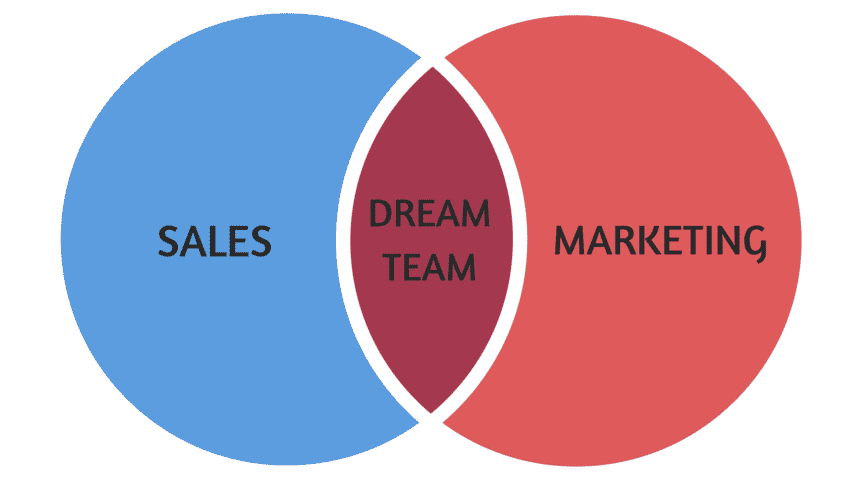
How Can Sales-Marketing Alignment Benefit YOUR Organization?
Is it worth your time to sync the goals and activities of the two departments? Or perhaps they are already working together well? (Or so you think.)
Leaders need to ask themselves:
- What is the structure of our sales and marketing teams? Are the functions and responsibilities combined or clearly demarcated?
- What is the exact nature and path of our customers’ journey to purchase?
- What percent of our qualified leads are converting?
- Are customers happy with our product? What feedback are we receiving and using?
Your answers will help you pinpoint exactly how alignment will improve your conversions and sales velocity. I can’t stress how important this is – every experienced marketer I’ve talked to agrees that the sales and marketing processes should be merged as closely as possible, primarily because the nature of the sales funnel itself has changed.
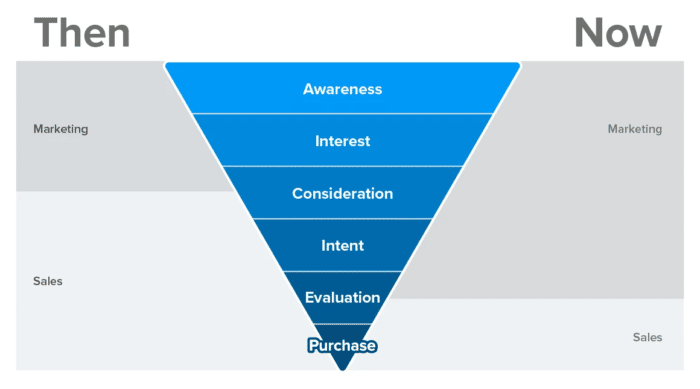
Source: Superoffice.com
Here is a process that will help you put in place closely aligned and conjoined strategies between sales and marketing so that they can work as one, towards one objective – more revenue, faster.
1. Set Shared Goals
Whenever there is a disconnect between Sales and Marketing, you’ll notice it always stems from the two team’s seemingly disparate goals. The marketing team is expected to generate as many leads as possible, while the sales team is under pressure to turn those leads into paying customers.
This often causes the former to focus on volume at the expense of quality, while the latter tends to blame failure to close on the marketing team for not qualifying leads effectively.
One way to unify these two teams is to focus your efforts on results by making ROI the responsibility of the whole company, not just individual teams. When both teams see the bigger picture, the whole organization benefits by having a shorter sales cycle and better target market profiling. This gives you the ability to close the gap between lead quantity and lead quality.
Further, shared goals aren’t just for sales and marketing. It is for every individual and every department in the organization. And that is why it is so important to have a culture that clearly communicates your vision, and then hire cultural best-fits in marketing and sales teams.
Once everyone is clear on the company’s vision and where it is going, what is the market, what is the target audience, how the product is being developed, why it has certain features and not others, it will be simpler for team members to have a shared vision of the buyer’s funnel, identify leads and nurture them along the ideal conversion path.
This is when your sales and marketing goals are truly shared. The business-specific objectives could could be:
- Increase quarterly revenue
- Reduce customer churn
- Increase CLTV
The key to achieving this ideal scenario is communication.
Communication is not the same as recording of instructions or feedback. It should happen not once, not periodically, not in meetings, not in emails, but constantly – with every move you make towards your revenue and sales targets. Just like a guided missile that has locked on to a target sends constant information to the command center and corrects its course.
Your communication tools, CRM and VPs of Sales and Marketing will serve as your command center.
Slack is ideal for inter- and intra-departmental communication. It’s the popular favorite in most B2B organizations.
While the goal-setting process is being reviewed, it’s also the best time to revisit your choice of CRM. Again, a common choice here is HubSpot CRM, which has been built from the ground-up to seamlessly move between inbound marketing and core sales functions. You can create forms, record emails and social conversations, log calls and live chats, schedule meetings, and manage your pipeline with a very small learning curve.
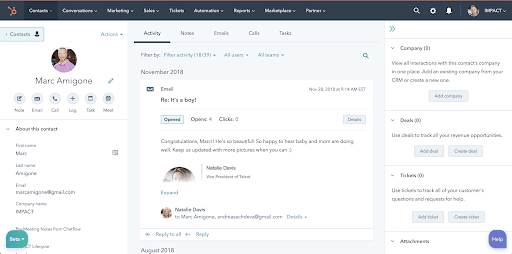
2. Perfect a Demand Generation Model
HubSpot defines demand generation as:
“Demand generation is the marketing system and engine that bridges the gap with your company’s sales and revenue operations. It may include multiple touch points, from blogging, to email list creation, to social media promotion — all inbound marketing tactics that are part of a company’s overall demand generation strategy.”
However demand generation is not part of marketing or sales. It isn’t synonymous with inbound marketing or lead generation.
Demand generation is the glue that binds marketing and sales.
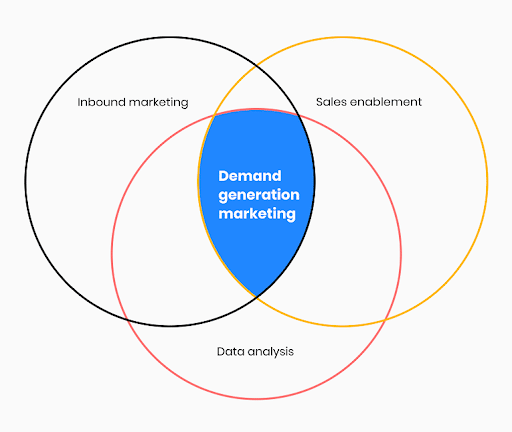
This means that any planned activity that could potentially result in a sale can be considered demand generation.
It is a process that goes on at every stage of the funnel:
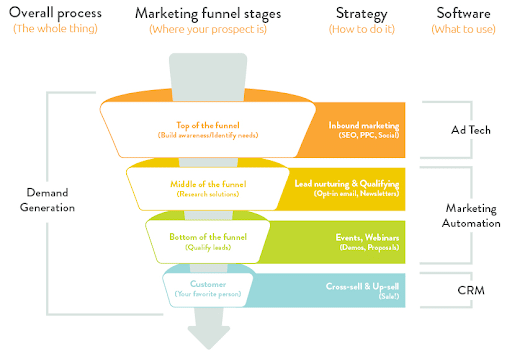
Source: Hilemangroup.com
Sales and marketing should thus be clear on
- what stage of demand generation is in their control
- what tools they can use to keep the customer moving forward
- where to automate
- which touchpoints need human interaction for a better customer experience
If you can get them to agree on this, you’ll be able to build a great Lead to Revenue Model (L2RM) that you can use to track and improve your conversions, with specific metrics and team accountability at each stage.
3. Choose the Best Tools and Build Your Martech Stack
What is the martech stack? A collection of technologies that you can use to optimize and augment your marketing and sales processes throughout the customer lifecycle.
The number of inbound and outbound marketing tools is burgeoning day by day. Any small task or part of a campaign can now be performed by a tool. Scott Brinker’s Marketing Landscape has bloated to 8,000+ apps and software as we speak.
And yet, marketing isn’t getting simpler. HubSpot reported that 26% of marketers failed in finding the right technologies to fit their needs!
Why? Because they don’t coordinate with their sales team about the outcomes that they deliver using the tools — whether it actually results in a conversion or not.
Marketing and sales can coordinate on evaluation, purchase, and usage of tools across the stack. It’s important to remember that even if the tasks they perform are different, the goals they’re pursuing are shared.
The secret to building a workable and effective martech stack that both marketing and sales teams can use is to correctly identify the problem that you’re trying to solve with each tool — whether it is brand awareness, lead scoring, web analytics, or retargeting.
It is by no means a simple process, as you need to take into account everything from demand planning to post-sale customer service. Here’s how Microsoft does it:
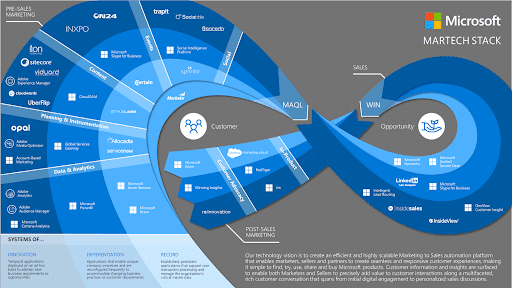
Without this clarity and sales-marketing alignment, your martech stack could turn into a Frankenstack. Ask yourself these questions so you don’t go wrong:
- Have we done enough research? Do we really need this new technology? Or are we suffering from the shiny object syndrome?
- Do we have the skills to use it to optimum level and maximize ROI?
- Does it integrate with our existing applications?
4. Refine Lead Scoring and Qualification
So you’re clear on your target market, your customer journey, your buyer’s funnel and your martech stack. This is where you finally get down to business.
One of the biggest points of contention between traditional marketing and sales teams is the definition, handover, and acceptance of MQLs and SQLs. Marketing blames Sales for not converting leads and Sales chastises Marketing for low quality leads.
Who is right? Neither. Research shows Sales ignores half of the leads that Marketing sends their way, while barely a quarter of these leads are qualified. Clearly, this is where the real alignment or “sync” needs to take place.
What is lead scoring anyway? Lead scoring measures the buyer intent of a qualified prospect and their potential value to the organization. Most lead scoring tools and methods calculate and assign scores based on the attributes of the prospect and their engagement with the brand so far.
This data is collected in two ways — it is either provided by the leads themselves or gathered by their behavior at offline or online touchpoints. The amount of data that can go into your lead scoring model, therefore, is huge. And that is exactly why an accurate lead scoring model that is acceptable and sustainable to both sales and marketing teams is necessary for the lead nurturing process to start off on the right foot.
While lead scoring is a feature that falls under the purview of software in the lead tracking, CRM, or sales automation categories, here’s a template from Demand Metric that will get you going.
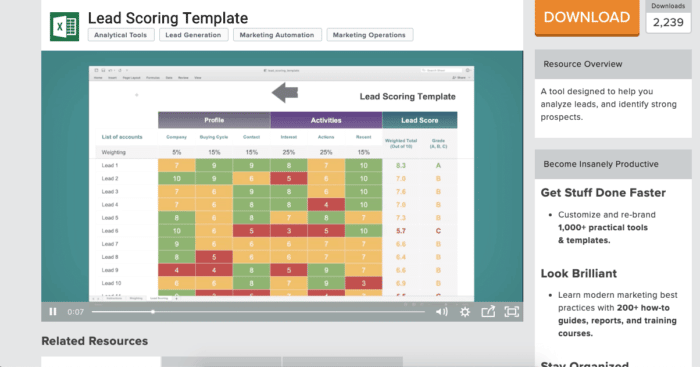
And here’s a great way to test different approaches and figure out one that works for you.
When your marketing and sales team both work in sync, the data and feedback that they put back into the system can be invaluable in improving the accuracy of your lead scoring, especially if your martech stack boasts of a tool that uses predictive analytics to score, qualify and nurture leads.
5. Develop Full-Funnel Content
Consistent brand messaging is the hallmark of good sales-marketing alignment. If the marketing and PR teams refer to product features using different terms than the product or sales teams, the consistency of your messaging and customer experience goes for a toss.
It is critical to map your content to the customer journey. Marketing needs to make Sales understand (and Sales needs to make a real effort) the exact role content plays in nudging leads and prospects down the funnel. A joint study by CMI and LinkedIn found that when sales and marketing are in sync, they know far better how and when to use content, as well as how to judge its effectiveness.
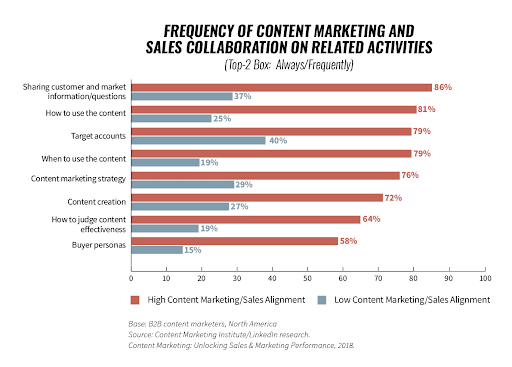
- Know who your ideal audience and customers are. Creating personas should be a joint effort between the marketing and sales (and product and customer service) teams. This collaboration will help teams understand the biggest pain points of your customers.
- Create a unified content journey that is personalized and delivered contextually at every touchpoint to every customer. Teams should be able to create, recognize, and promote ToFU, MoFU, and BoFU content in the right formats, using the right channels.
- Take a “marketing-first” approach to content. You should first prioritize inbound marketing methods, starting with solving for the audience. Then comes brand awareness and recall. Finally, if needed, you might test out “salesy” content, cold calls or bulk emails, as few prospects are likely to respond to these. Deals and offers should be carefully worked out between marketing and sales.
- Track and use the same content metrics and KPIs.
- Whatever feedback is received by either team should immediately go into the CRM with the appropriate notes.
6. Expedite Lead Nurture Sequences from Marketing Automation to CRM and Back
For better coordination and smoother flow of leads, Marketing should provide Sales with precise reasoning on why they are being handed over, along with the following information and context:
- the action prospects took to get into the marketing database
- the lead score
- the attribute or interaction that led to qualification
For this to happen, the correct marketing intelligence fields need to be mapped from the channel-specific or stage-specific martech or automation tool to the CRM.
In return, Sales needs to make sure Marketing has access to up-to-date CRM data, and accurate customer segmentation data that they can feed into the marketing automation tool, in order to target new as well as existing customers.
This way, you can connect every lead that flows into the marketing database to sales or CRM outcomes.
A practical problem with a bi-directional sync like this is that a perfect sync of the marketing automation list with the CRM database is not possible, as the CRM would have minimum data requirements to create records. For example, a new subscriber to your newsletter will have given you just her name and email, which isn’t enough to create a new CRM record.
However, pulling MQLs back from your CRM to the marketing automation app can match an email list or social media Custom Audience email in your automation tool, allowing the sales team to cherry pick leads that they can follow up with immediately.
If you use HubSpot, these would be Marketing Qualified Leads in the Lifecycle Stage field. Here’s a great article on how to automate movement between different stages in HubSpot based on action triggers.
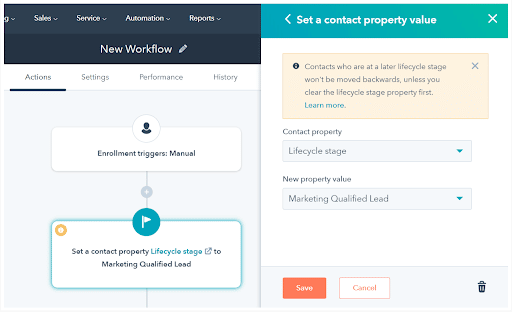
When you sync data back from the CRM to your automation tool, you can either automate the lead nurturing stream or allow a sales rep to choose or customize the sequence. This field in your CRM can be the trigger for the marketing automation software to begin its sequence. And oh, make sure you remove the contact from the nurture stream (such as remarketing list) from the automation app when the sequence has run its course!
7. Align Data, Track and Report on the Same Metrics
With a bi-directional data sync and lead nurturing cycle, both marketing and sales teams can identify metrics and KPIs that are important to them, and then agree on how to track these. These metrics might be reported in different ways or have different values in the automation and CRM systems, so the teams need to agree on how to close the loop.
Start co-tracking the basic metrics — such as Conversion Rate of MQLs, Customer Retention Rate, and Churn Rate — and then move on to deeper levels or add more metrics as your demand generation, attribution and lead-to-revenue models mature. You can use tools such as Klipfolio to create customized dashboards that allow you to focus on key metrics, trends, and performance indicators.
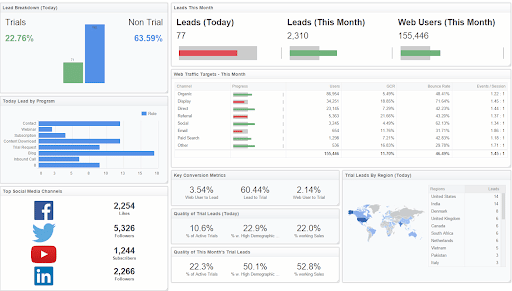
Here’s how Kyle Lacy, VP of Marketing at Lacy, makes sure his sales and marketing teams are measuring and analyzing outcomes together: “We have many goals that are known and public within the marketing team. We’re responsible for leads, MQLs and ACV (average customer value). We even have a goal for demo ratings. Each time sales does a software demo, they rate it 1-5. If they score it below a 3 in quality of prospect, we meet to determine why.”
This level of scoring, tracking, and collaboration between Marketing and Sales ensures full transparency and removes chances of any confusion in either side.
One thing to bear in mind is that no data or information is permanently useful. Your syncing methods need to evolve with your audience’s behavior and characteristics (and your product). So does your L2RM.
So don’t stop at data. Move on to shared tasks and activities where both teams have the opportunity to glean more information they think they can put to good use.
A great suggestion comes from Jeff Rohrs of Yext, who thinks it’s imperative to have Marketing listen in on sales calls. “Our approach is to understand at a deep level what’s going on in the sales opportunities, and we want our marketers in those calls hearing what’s important, what’s moving, where they can potentially add some relationship building efforts,” he adds.
Sales-Marketing Alignment Best Practices
Here’s a quick intro video to get you started:
Here are a few tips you can implement to help align your sales and marketing teams quicker and better…
1. Hold Regular Meetings
It may sound obvious, but it can be a challenge to set aside time for regular meetings especially when there are deadlines to meet and time becomes a scarce resource.
The only way to share goals and benchmarks is to be on the same page.
You should always make time to catch up because these knowledge sharing sessions play a significant role in the alignment process. Make the most of these meetings by having a clear agenda to share processes, resources, and best practices on both ends.
Marketers must be kept updated on the sales team’s progress when it comes to meeting their quotas and goals because it allows marketing to offer specific support when needed.
2. Secure Executive Commitment
You have a better chance of success if you secure the backing of key personnel from the C-suite. This puts a considerable emphasis on unity and sends a clear message throughout the organization that you mean business.
This is especially important in companies where the rivalry is clear between these two functions. Executive level buy-in will help neutralize tensions and ensure that everyone is on the same page.
3. Don’t Tie ROI Solely to Sales
Marketing has traditionally been more concerned with bringing in as many leads as possible. As such, most have failed to keep track of how their lead generation efforts contribute to overall revenue.
Alignment between the two teams means that marketing has to develop strategies with metrics focused on revenue generation. KPIs such as “deals influenced” or “deals sourced” can be included to help tie in campaigns with bottom line results for your MROI.
4. Come Up with a Common Set of Definitions
This ensures that both teams are on the same page both literally and figuratively. This also promotes clear and effective communication across teams, so confusion and misunderstandings are minimized.
Creating common definitions can help both teams vocalize their perspectives on certain aspects of the business.
For example, a “lead” can mean different things to different departments. How qualified are these leads and what does it take for a prospect to be classified as a lead? Don’t hesitate to be as granular as possible for best results.
5. Agree on a Single Customer View
Both teams must take the time to define their exact target audience. There must be a clear picture of the ideal customer, which can be achieved by sharing both teams’ unique knowledge.
Familiarize yourselves with each customer touchpoint until you come up with a well-rounded picture based on mutual insight and common goals. Customer profiles are necessary for defining your KPIs and overall goals as a business.
6. Marketing Should Keep Sales Updated on Upcoming Campaigns
Make an effort to ensure that any new campaign or content launched has been shared with the sales team. This promotes a seamless front so that the sales team can directly engage the leads who have consumed these new marketing materials.
Make sure that marketing is coordinating with sales whenever a new email blast is sent out, or any new leads have been acquired. This will not only give additional insight into a customer’s interests, but it will also provide sales reps with an idea of what motivates leads to take the next step.
7. Use a Closed-Loop Feedback System
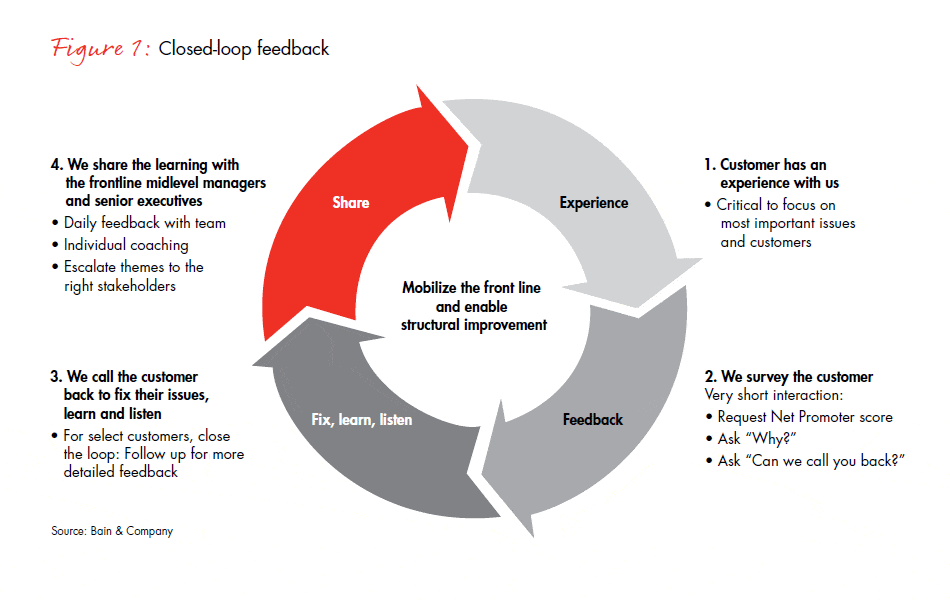
Source: Bain & Company
The sales team communicates with leads or prospects regularly, so they are in the best position to tell you what your customers need. However, they don’t always have the time to record these insights, which can lead to a breakdown in communications.
One way to address this issue is to use shared documents to collect ideas and references. Holding regular brainstorming sessions where the sales team can share what they know about attracting leads or what types of content would resonate the most with prospects.
A closed-loop feedback system will ensure open communication and that all opportunities to leverage customer data are being taken advantage of.
8. Implement Strategic Content Creation
Don’t simply leave content creation to your content team. Your entire company is full of potential knowledge that can help improve the quality of your content, and you should be taking advantage of it.
Your sales teams have an intricate knowledge of what customers want, so why not use them to help develop content that is more appropriate for your audience?
You can interview them, ghostwrite for them, or if they’re so inclined, have them write the post themselves. This will provide you with new knowledge channels and help with employee activation.
9. Lead Quantity and Quality Must Work in Tandem
Optimize your lead generation efforts by finding the right balance between lead quantity and lead quality. The best possible combination will differ depending on the type of company and its industry.
To find a balance that works specifically for you, you’ve got to test, test, and test some more. Ask yourself questions such as:
- Could we improve sales conversion rates if we focus more on the qualification process?
- Could we increase lead volume if we focused less on the qualification process?
Find out how shifting the focus affects ROI to find the best possible practice for your business.
10. Make Sales-Enablement Resources Easily Accessible
Brochures, presentations, overviews, and other marketing materials should be placed in a shared area (like Google Drive) so that the sales team can easily get hold of these resources to support their activities.
Include your marketing strategy, campaign calendar, relevant offers, blog posts, and other content tailored for specific customer personas in this shared file. With more contextually-relevant information, sales teams will be able to tailor their sales pitch more effectively.
Over to You
In most organizations, sales and marketing have historically operated independently of each other. It’s rare to find these two functions working perfectly as a unified team with common goals.
In many cases, there’s even a rivalry between the two, because both sides fail to see how each one can benefit from the other. While some teams have successfully found common ground without outside interference, the best approach is to assign managers and personnel to oversee their alignment.
This responsibility primarily rests on key decision makers, as they have the power to set operational objectives. Expect some form of resistance from your marketing and sales teams, because nobody likes change.
With a keen focus and a proper plan in place, you’ll be seeing higher conversion rates, better performance from both sales and marketing teams, and a more functional working environment altogether.
The tools, methods, and resources available today to sales and marketing teams, even in SMBs, are virtually limitless. So what’s stopping you?
If you’re facing bottlenecks in your digital marketing campaigns, or if your content falls short of delivering brand value, get in touch with me and I’ll help you build effective, data-driven content marketing and conversion optimization strategies.






